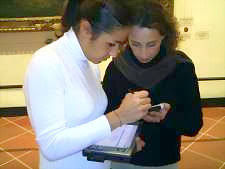Remote Usability Testing:
 | Remote testing, is about conducting usability testing without having participants come into the lab. Although there are several tools and web services on the market, I prefer to work with userfeel because of the low cost, and their massive network of testers from all over the globe. |
A/B and Multivariate Testing:
 | A/B and multivariate testing, is about testing different versions of the same design, in order to see which performs the best. I use this technique in all of my usability tests, either by differentiating my designs across one variable (i.e., A/B testing) or more (i.e., multivariate testing). |
Co-Discovering Learning:
 | My approach to co-discovering learning, is as follows: I usually ask two or more users to perform a task together, while I observe them. I encourage them to converse and interact with each other to create a “team spirit”. In some cases, I also allow note taking (e.g., when the content is technical/complex). The technique can yield some really powerful results, as it is more natural for users to verbalise their thought during the test. |
Participatory Design:
A4.0 Inspection Methods
Cognitive Walkthrough:
 | The cognitive walkthrough is a method of “quick and dirty” usability testing requiring a number of expert evaluators. A list of tasks and the actions to complete them is created. The evaluators step through each task, action by action, noting down problems and difficulties as they go. I can use cognitive walkthroughs on a number of digital interfaces, ranging from web sites to complex authoring toolkits. |
Heuristic Evaluation:
 | Heuristic evaluation is about judging the compliance of an interface against a number of recognized usability principles (i.e., the Heuristics). I used this method extensively in the evaluation of e-learning prototypes during my teaching at Middlesex University. |
A5.0 Advanced Usability Techniques (in training)
Eye Tracking:
Emotion Recognition & Eye Tracking
 | This is a technique I developed during the MGUIDE project. I discuss it in detail here. It was developed with avatar-based interfaces/presentation systems in mind, but it is universal in nature. It is based on the hypothesis that the perceived accessibility of a system’s content is evident in the user's emotional expressions. The combined “Emotion Recognition and Eye-tracking” technique will be validated in a lab-based study that will be performed at Middlesex University. |
A5.0 Audits
Accessibility Audit:
 | In accessibility audit, an expert checks the compliance of a web site with established guidelines and metrics. The W3C WAI are the most widely used guidelines in accessibility audits. My approach for accessibility evaluation is framework-based (see here), but a) I haven’t applied my framework with disabled users and b) the W3C WAI heuristics are very well established. Although I have a good knowledge of the W3C WAI heuristics, I have never performed an accessibility audit before. |




0 comments:
Post a Comment